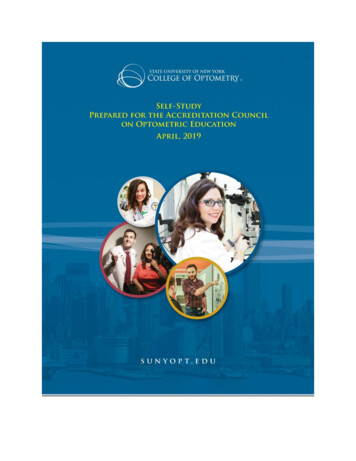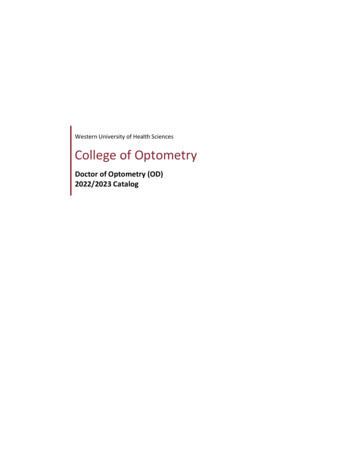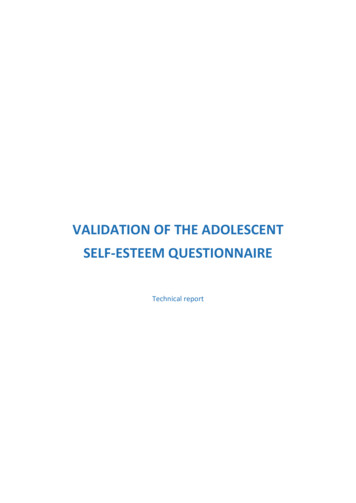
Transcription
ACOE SELF-STUDYApril, 2019Table of ContentsList of Appendices2Standard I – Mission, Goals and Objectives7Standard II – Curriculum25Standard III – Research and Scholarly Activity40Standard IV - Governance, Regional Accreditation, Administration, and Finances47Standard V – Faculty57Standard VI – Students66Standard VII – Facilities, Equipment and Resources84Standard VIII – Clinic Management and Patient Care Policies96Instructions for Navigating this PDFThis PDF contains the Self-Study narrative and all appendices. Links to appendices and otherpages within the PDF are in underlined bold green font. You may left-click on a link to access anappendix. To return to the location of the link, simultaneously depress “Alt” and the back arrow( ). Mac users should depress the command and open square bracket ( [ ) if using Adobe Previewor the command and back arrow if using Adobe Reader. Most Mac users have Preview.To provide the reader with a richer sense of our institution, this document also includes links tovarious pages on the College’s website. These are denoted in underlined blue font. In those caseswhere a permanent record of a webpage is required, a PDF has been created and included in theappendices.1
List of AppendicesStandard I: Mission, Goals and ObjectivesAppendix I-1College Mission, Goals and ObjectivesAppendix I-2Strategic Plan WebpageAppendix I-3College Assessment PlanAppendix I-4Completion & Attrition RatesAppendix I-5a Part 1 NBEO ScoresAppendix I-5b Part 2 NBEO ScoresAppendix I-5cPart 3 NBEO ScoresAppendix I-5d Ultimate NBEO Pass RateAppendix I-6Institutional Research WebpageAppendix I-7Factbook WebpageAppendix I-8a AIM Presentation: Academic AffairsAppendix I-8b AIM Presentation: Student AffairsAppendix I-8cAnnual State of the College Address (2018)Appendix I-9Institutional GoalsStandard II: CurriculumAppendix II-1Program Learning ObjectivesAppendix II-2Course CatalogAppendix II-3Curriculum MapAppendix II-4aCore Clinical Competencies (Learning Objectives)Appendix II-4bClinic Grading FormAppendix II-5Electives CatalogAppendix II-6Advanced Standing ProgramAppendix II-7aNBEO Analysis: Content, ConditionAppendix II-7bNBEO Analysis: DisciplineAppendix II-8aStudent Rating of Didactic TeachingAppendix II-8bStudent Rating of Clinical TeachingAppendix II-9aOD Exit Survey ExampleAppendix II-9bOD Exit Survey Highlights SampleAppendix II-10a OD Alumni Exit Survey ExampleAppendix II-10b OD Alumni Survey Highlights SampleAppendix II-11a Sample Curriculum Committee MinutesAppendix II-11b Curriculum Proposal for Clinical OptometryAppendix II-12a Third-Year Student Patient Encounters ReportAppendix II-12b Fourth-Year Student Patient Encounters ReportAppendix II-13a Externship Site CriteriaAppendix II-13b External Site Visit ChecklistAppendix II-13cExternship Weekly Patient Log Form2
Appendix II-13dAppendix II-13eAppendix II-13fAppendix II-13gAppendix II-14aAppendix II-14bAppendix II-15Student Rating Form of Externship Site & FacultyExternship Site VisitationsExtern Program Learning ObjectivesExtern Grading FormExternship Supervisor ManualExternship Student ManualSUNY Expo Agenda (2018)Standard III: Research and Scholarly ActivityAppendix III-1Publications and PresentationsAppendix III-2NYC Vision ProgramsAppendix III-3aGrants Activity LongitudinalAppendix III-3bGrantsAppendix III-4First-Year and Total OD-MS EnrollmentAppendix III-5Graduate Policy DocumentAppendix III-6Example of T-35 PresentationsStandard IV: Governance, Regional Accreditation, Administration, and FinancesAppendix IV-1SUNY BOT PoliciesAppendix IV-2aSenior Management Organization ChartAppendix IV-2bArea Organization ChartsAppendix IV-3aSenior Management Position DescriptionsAppendix IV-3bGoverning CouncilsAppendix IV-4Education Law Section 356Appendix IV-5Faculty HandbookAppendix IV-6aNondiscrimination PolicyAppendix IV-6bDiversity and Inclusion Master PlanAppendix IV-7UUP ContractAppendix IV-8Copyright Guidelines and ResourcesAppendix IV-9FERPAAppendix IV-10Example of FY EyeAppendix IV-11Example of State of the College AddressAppendix IV-12Presidential ReviewAppendix IV-13MSCHE Periodic Review Report (PRR)Appendix IV-14Reviewer’s Report on MSCHE PRRAppendix IV-15MSCHE Accreditation StatusAppendix IV-16President’s CVAppendix IV-17Chief Academic Officer’s CVAppendix IV-18a Administrator Evaluation FormAppendix IV-18b Example of Annual Institutional GoalsAppendix IV-19IPEDS Budget DataAppendix IV-20SUNY Policies and Procedures3
Appendix IV-21Appendix IV-22Standard V: FacultyAppendix V-1Appendix V-2Appendix V-3Appendix V-4Appendix V-5Appendix V-6Appendix V-7aAppendix V-7bAppendix V-8aAppendix V-8bAppendix V-8cAppendix V-8dAppendix V-9aAppendix V-9bAppendix V-10Appendix V-11Appendix V-12NYS Comptroller’s Guide to Financial OperationsInternal ControlFaculty Employment StatusFTE by DepartmentDistribution of Faculty DegreesFaculty List by Rank with DegreesFaculty Salary AnalysisCommitteesExample of Faculty Retreat AgendaCOACHE Survey ResultsFaculty Effort WorksheetBVS Faculty Annual ReportClin Ed Faculty Annual ReportUEC Faculty Annual ReportFaculty Development ProgramsJournal Club MeetingsSIVR ColloquiaFaculty AdsDiversity Report (2018)Standard VI: StudentsAppendix VI-1Admissions PolicyAppendix VI-2aAdmissions BrochureAppendix VI-2bAdmissions BrochureAppendix VI-3Colleges VisitedAppendix VI-4aCSTEP BrochureAppendix VI-4bCSTEP WebsiteAppendix VI-5aAdmissions RequirementsAppendix VI-5bPrerequisite CoursesAppendix VI-5cJoint Degree RequirementsAppendix VI-6Interview Scoring GuideAppendix VI-7Student HandbookAppendix VI-8Student Affairs Position DescriptionsAppendix VI-9aVPSA ResumeAppendix VI-9bDirector of Financial Aid ResumeAppendix VI-9cRegistrar ResumeAppendix VI-9dAssociate Director of Admissions ResumeAppendix VI-9eDirector of Career Development ResumeAppendix VI-10Financial Aid and HousingAppendix VI-11a Financial Aid Letter4
Appendix VI-11bAppendix VI-12Appendix VI-13aAppendix VI-13bAppendix VI-14Appendix VI- 15Appendix VI-16Appendix VI-17Appendix VI-18Appendix VI-19Appendix VI-20aAppendix VI-20bAppendix VI-21Appendix VI-22Appendix VI-23Appendix VI-24Appendix VI-25Appendix VI-26Appendix VI-27Appendix VI-28Appendix VI-29Appendix VI-30PDF of Mental Health WebpageFMP Flyer2018 Annual Career Symposium2016 Annual Career SymposiumFERPAStudent Consumer Information PageFact SheetView BookFactbook Home PageStudent HandbookOD Program Website Resources 1OD Program Website Resources 22018-2019 Semester CalendarTuition and FeesFinancial AidRefundsStudent ConstitutionStudent Clubs and OrganizationsResidency ProgramPercent Planning to Enter a Residency ProgramGraduate ProgramsMBA Certificate ProgramStandard VII: Facilities, Equipment and ResourcesAppendix VII-1Space AllocationAppendix VII-2Capital ProjectsAppendix VII-3Equipment Replacement PolicyAppendix VII-4Annual Budget Request LetterAppendix VII-5Annual Budget Request FormAppendix VII-6Property Control MemorandumAppendix VII-7Equipment ListAppendix VII-8Library ExpendituresAppendix VII-9Utilization of Electronic ResourcesAppendix VII-10 Library Patron AssistanceAppendix VII-11 Library Director CVAppendix VII-12 Associate Librarian CVAppendix VII-13 Library Staff ResponsibilitiesAppendix VII-14 IT Organization ChartAppendix VII-15 IT Equipment Replacement PolicyAppendix VII-16 College Emergency Response Plan5
Standard VIII: Clinic Management and Patient Care PoliciesAppendix VIII-1Satellite LocationsAppendix VIII-2Organizational Chart for Major Clinical ServicesAppendix VIII-3a Floorplans for Patient Care FloorsAppendix VIII-3b Floorplan for Clinical Administrative FloorAppendix VIII-4Clinical Charitable ContributionsAppendix VIII-5UEC Organization ChartsAppendix VIII-6UEC Policy and Procedure ManualAppendix VIII-7Changes to UEC Policy and Procedure ManualAppendix VIII-8Clinical PrivilegesAppendix VIII-9Example of QA ActivityAppendix VIII-10 Patient SurveysAppendix VIII-11 Compliance ReportAppendix VIII-12 Patient Welcome BookAppendix VIII-13 Student Liability6
Standard I – Mission, Goals and Objectives1.1 The program has a statement of its mission, and the goals and objectives by which it intendsto fulfill its mission.The College’s mission, goals and objectives are reviewed regularly and updated as describedunder Standard 1.5. The most recent review of the mission, goals and objectives occurred in2017-18 as part of the College-wide strategic planning process undertaken every five years. TheCollege’s new and intentionally concise mission is as follows:The State University of New York College of Optometry advances visual health and patientcare through leadership in education, research and service.The new 2018-23 strategic plan, Care, Lead, Advance, which may be found in Appendix I-1,includes nine goals with objectives that support five key themes. The themes and goals are listedbelow:Student-Centered Experience1. Enhance the student experience through programs that promote student and alumnisuccessAcademic Excellence2. Deliver a dynamic curriculum that engages students and advances contemporaryoptometry3. Grow the graduate and research programs to increase the institutional impact on theadvancement of knowledge and to produce leaders in vision research (basic, translationaland clinical)Service to Our Patients and Community4. Deliver unparalleled care to our University Eye Center Patients5. Provide Service to the greater communityCommunity and People6. Cultivate an institutional culture that encourages a sense of community, inclusion,institutional pride, collective purpose and shared responsibility7. Promote the growth and development of all members of our communityEffective Foundational Support8. Attract the brightest and most motivated students with demonstrated leadershippotential9. Provide the financial foundation, administrative support and environment to achieve theCollege’s mission7
1.1.1 The program publishes its mission and goals so that the information is readily and publiclyavailable on the program’s website.The College’s current and recent prior strategic plans, which include its mission, goals andobjectives, are published on its website at https://www.sunyopt.edu/about/strategic-plan. A PDFof this page can be found in Appendix I-2. The current strategic plan, Care, Lead, Advance, whichwas formulated in 2017-18 as discussed under Standard 1.5, is posted on this page.1.1.2 The goals and objectives include teaching and learning, research or scholarly activity,patient care, and service.As can be seen in Appendix I-1, the College’s goals and objectives include teaching and learning(Goals 1 and 2), research/scholarly activity (Goal 3), patient care and service (Goals 4 and 5).1.2 The mission, goals, and objectives result in a professional optometric degree programwhose graduates possess the attributes, knowledge, skills, and ethical values required forindependently practicing contemporary optometry.The College’s mission is to advance visual health and patient care through leadership ineducation, research and service. As discussed previously, goals and objectives supportive of thismission are articulated in the 2018-23 strategic plan, Care, Lead, Advance (Appendix I-1).The College’s mission, goals and objectives give rise to the professional program’s statement ofattributes, knowledge, skills and ethical values, which can be found in Appendix -program/goals/what-students-learn. Thisdocument, which represents the program’s curricular learning objectives, serves as the basis forcurriculum development. It is periodically reviewed by the Dean’s Council to ensure it adequatelysupports the independent practice of contemporary optometry. Course learning objectives arederivative of these program learning objectives, and assessment of student knowledge andcompetencies supports their attainment.1.3 The program identifies and uses outcomes measures to evaluate its effectiveness bydocumenting the extent to which its goals and objectives have been met and must use suchassessment to improve its performance. Such measures include but are not be limited tograduation rates, and results from National Board of Examiners in Optometry (NBEO),Canadian Assessment of Competency in Optometry (CACO) or equivalent testing agencies.OverviewAssessment of student learning at the program level occurs through multiple mechanisms,including tracking of the following key performance indicators: Performance on national licensing examination (NBEO)o Part 1: Applied Basic Scienceo Part 2: Patient Assessment and Managemento Part 3: Clinical Skills Percentage of graduates who intend to enter a residency program Quantity and nature of each student’s patient-care experiencesOther sources of information include:8
Annual exit surveys (An example of the survey and a summary of results are provided inAppendices II-9a and II-9b.)Annual alumni surveys administered to the class that graduated about 6 years previously.(An example of the survey and a summary of results are provided in Appendices II-10aand II-10b.)Assessment of student learning is an integral component of the College’s assessment plan(Appendix I-3 or /Assessment Plan.pdf).Data collected for the OD program are analyzed to determine if students are meeting theprogram’s educational leaning objectives. When data suggest substantive shortcomings,potential solutions are formulated and implemented. While the analysis and formulation ofpotential solutions may be initiated at various administrative levels related to the OD program,the forums/offices best suited for analysis, planning and implementation are: Curriculum CommitteeDean’s CouncilClinical Education CouncilDepartment ChairsNBEO PerformanceFrom 2011-2017 about 97% of graduating students passed all 3 parts of the NBEO examinationby the time of graduation.1 As indicated in the following graph, the percentage of our studentswho have passed all three NBEO parts at graduation is consistently above national comparisonvalues:2Percentage of Candidates who Passed all NBEOParts at Graduation10095National90SUNY8580752011 2012 2013 2014 2015 2016 2017 2018Year of Graduation1Most, if not all, of the students not passing all three parts by graduation are foreign national students who arereturning to their countries and not planning to practice in the United States.2The data in this and the following three graphs were provided by NBEO. National 2018 comparison data forpassage of all NBEO parts were not available at the time this document was finalized9
This overall performance reflects performance on each of the three individual NBEO parts. Thefollowing graphs show that in 27 of 30 recent administrative years our students (first-time takers)performed at or above the national comparison values on Parts I, II and III:NBEO Part I (Applied Basic Science)100%95%90%85%80%75%PercentPassing (1st 70%Time Takers) 65%SUNY Part I60%55%National Part I50%2009 2010 2011 2012 2013 2014 2015 2016 2017 2018YearNBEO Part II (Patient Assessment and Management)100%95%90%Percent85%Passing (1stTime Takers) 80%75%SUNY Part IINational Part II70%65%Year10
NBEO Part III (Clinical Skills)100%95%90%Percent85%Passing (1stTime Takers) 80%75%70%SUNY Part IIINational Part III65%2008 2009 2010 2011 2012 2013 2014 2015 2016 2017YearThe NBEO provides the College with detailed reports that show how its students perform on thevarious topics tested on each of the three parts of the exam. These reports are routinely reviewedby the dean and discussed with department chairs as warranted. When indicated, data areanalyzed for trends in performance over multiple administrations. Appendices II-7a and II-7bshow an analysis of performance on Part I.Graduation RatesAs indicated in the table below, a high percentage of entering students complete the ODprogram in a timely manner:Percentage of Entering Students who ll EnrolledGraduated in 5 ormore yearsGraduated in 4 years2005 2006 2007 2008 2009 2010 2011 2012 2013 2014Entering Year11
Intent to Enter a Residency ProgramIn the spring semester, the office of residency programs administers a survey to graduatingfourth-year students to assess intent to enter a residency program. Results for recent surveys areas follows:SUNY Graduates Planning to Enter a Residency Program504030Percent201002009 2010 2011 2012 2013 2014 2015 2016 2017 2018Year of GraduationIn recent years, about 40% of graduates have indicated they intend to complete a residencyprogram.Examples of Use of Assessment to Improve Student Learning in the OD ProgramAs detailed in the College’s assessment plan (pages 7-9 of Appendix I-3) data on student learningoutcomes are routinely collected, disseminated, analyzed and used for OD programimprovement. Recent examples (in no particular order) are discussed below.Virtual Reality SimulatorsIn response to the need to train students on more complicated optometric skills and keeping withour aim to prepare them for clinic earlier, the College initiated the development of a virtual realityteaching laboratory. This laboratory, which has been in use since 2015, provides students withgreater opportunities for learning and practicing skills with greater independence. The labcurrently has two direct ophthalmoscopes and six binocular indirect ophthalmoscopes. We areworking with the manufacturer on the development of slit lamp biomicroscopes and plan to addthem when available in late 2019. Progress can be monitored accurately by faculty, and researchinto the effectiveness of the simulators versus traditional teaching methods is being planned.Low VisionAs part of the major curricular revision that was rolled out starting in 2008, the topic of low vision,which previously comprised a stand-alone course, was to be taught in several ocular diseasecourses in conjunction with the treatment of relevant clinical conditions. Low vision rehabilitation12
of the patient with age-related macular degeneration, for example, would be covered at the timethe clinical management of this condition was taught.Data from both exit surveys and NBEO examinations suggested that with this approach, studentlearning was falling short of expectations. For the Class of 2011, the last class to complete theold curriculum, 27% of the respondents believed that not enough lecture/lab time was devotedto the subject3. This value increased with the implementation of the new curriculum with valuesranging from 67% to 83% from 2012 – 2017 (exit survey data).NBEO data were consistent with student perceptions. Performance on questions related to lowvision was weak with respect to national data and SUNY student performance in other areas ofthe examination.These data were presented and analyzed at meetings of the IRPC, President’s and Dean’s Counciland Curriculum Committee. In 2014-15, the Curriculum Committee developed and passed adetailed proposal to address the shortcomings of low vision education. This proposalconsolidates low vision didactic instruction into a single instructional unit that consists of lecturesand laboratories. The proposal was approved by the Office of Academic Affairs and instituted inthe 2015-16 academic year as a course entitled Low Vision. It is now taught in the spring semesterof the third year and consists of 12 hours of lecture and 5 hours of lab.Notably, only 15% of the Class of 2018 – the first class to take the new low vision course -- didnot believe enough time was devoted to the subject, a substantial improvement over the 83%who expressed the same view in the 2017 exit survey. Although the number of items related tolow vision on Part I of NBEO is quite small (only 8 in spring, 2018), students who sat for the examin spring 2018 performed above the national average for the first time in five years. Exit surveysand NBEO performance will continue to be monitored to assess the effectiveness of thisintervention.Clinical MedicinePrior to the recent major curricular revision, clinical medicine was taught in a two-semestercourse devoted exclusively to this topic. In the revised curriculum, material covered in this coursewas distributed throughout courses in the biological ocular disease sequences with the goal ofbetter integrating it with related material. As was the case with low vision, student perceptionsof instruction in this area, as revealed by exit surveys, fell short of expectations. For the classgraduating in 2011, the final year of the old curriculum, 27% of respondents indicated that notenough lecture/lab time was devoted to the topic of general medicine. In the years subsequentto implementation of the new curriculum, higher percentages of students indicated that notenough lecture/lab time was devoted to this topic; from 2012 to 2017 the percentage rangedfrom 47% to 60% (exit survey data).3Exit surveys were initiated with the Class of 2011.13
These data were presented and analyzed at meetings of the Institutional Research and PlanningCommittee (IRPC), President’s and Dean’s Council and Curriculum Committee. In 2014-15, theCurriculum Committee developed and passed a detailed proposal to address the shortcomingsof clinical medicine education. This proposal consolidates certain aspects of clinical medicinedidactic instruction into a single instructional unit that consists of lectures and laboratories. Theproposal was approved by the Office of Academic Affairs and instituted in the 2015-16 academicyear as a course entitled Clinical Medicine. It is taught in the second year of the curriculum andconsists of 18 hours of lecture and 10 hours of lab. (Other material related to clinical medicinecontinues to be covered in related courses.) The topics covered are taught by several instructorsincluding ODs, MDs, DOs, and NPs and involve discussion of interprofessional interactions andcollaborative practice.Only 29% of the Class of 2018 – the first class to take the new general medicine course -- did notbelieve enough time was devoted to the subject, an improvement over the percentage thatexpressed the same view in previous years. Although SUNY performance on systemic healthitems of NBEO Part I have historically been strong, these scores and exit surveys will continue tobe monitored to assess the effectiveness of this intervention.Progress examinationsTo monitor and improve curriculum delivery of core material, Academic Affairs is in the processof implementing a series of comprehensive progress examinations to determine studentacquisition, retention, and integration of didactic material. The exams will be given in the earlyfall of second year, and in the early winter of third year (before boards). The general results ofthese exams will be used by department chairs and faculty IORs to identify and improve areas ofdifficulty. Specific results will be provided to each student to identify gaps in knowledge and guideadditional learning. Specific results of poorly performing students will be given to the directorsof the student advising program to identify and guide students needing academic assistance.Academic Advising and Remediation ProgramsAcademic Affairs, working with the Department of Biological and Vision Sciences, the Departmentof Clinical Education, and in collaboration with the office of Student Affairs, developed twoprograms to identify and assist the struggling student learner.1. The Academic Advising Program:In response to the difficulties and rigor of the academic program, an academic advising programwas developed in 2016 to identify and assist students in academic difficulty. These students areidentified throughout the first three years of the program by monitoring the results of earlyassessment each semester, academic performance at the end of each semester, reports fromIORs and when self-identified by students seeking assistance through Student Affairs or AcademicAffairs. Program directors are provided information on student performance and the studentsare contacted confidentially. Students who respond are provided advisors from the faculty whomeet the student. After an initial meeting where the student’s difficulties are assessed usingseveral tools to determine the areas of difficulty, strategies are developed to assist the student.These strategies are tailored to the student’s specific needs and may include tutoring in an area14
of deficiency, study skills, test taking strategies, and directions to find assistance for psychosocialissues.2. The Clinical Remediation Program:Students performing at or below minimal competency in clinical programs are identified usingthe clinical grading rubric. Since 2015, these students’ performance has been carefully reviewedby the Clinical Remediation Program Director working with a clinical education team made up of3rd and 4th year Clinical IORs, the director of externships, and the chair of the department ofclinical education. Competency in various areas are reviewed and difficulties diagnosed in suchareas as basic and optometric knowledge, skills, patient care and case decision making,communication, and professionalism are identified. A clinical enhancement plan is developed,and the clinical faculty “coach” is identified and paired with the student to remediate thedeficiencies.Electives in the Professional Degree ProgramIn response to student requests and the desire to provide more opportunity for students tocustomize their professional degree education by adding material that they find particularlyinteresting and valuable to them, after several years of planning we implemented an electiveprogram in AY 2013-14. The electives provide an opportunity for deeper treatments of specialtopics in small group environments and may contain both didactic and clinical trainingopportunities. The College continues to assess student interest periodically and expands itselective course offerings accordingly. A catalog of elective courses can be found athttps://www.sunyopt.edu/pdfs/academics/electives catalog sp17.pdf or in Appendix II-5.Expansion of the Fourth-Year Externship ProgramSince at least 1995, fourth-year optometry students had typically participated in up to two offcampus clinical rotations as part of the externship program. As part of the planning process forthe increased student enrollment that commenced in 2012, the College analyzed patient flow atits on-campus clinic, the University Eye Center (UEC), and determined that the increasedenrollment could potentially reduce the number of patients seen by students rotating throughthe UEC. Student exit surveys indicated strong student satisfaction with the externship program,and the number of patients seen by students at these sites was high as tracked by the Meditreksystem used for this purpose. These results helped inform the College’s decision to increase thenumber of external rotations from two to three during the 2014 – 2015 academic year. Exitsurveys continue to show strong student satisfaction with the externship program, and thenumber of student-patient encounters at these sites remained high.Revision of Clinical Optometry SequenceThe revision of the Clinical Optometry sequence was put into place at the start of the Fallsemester for the Class of 2020 (Appendix II-11b). The changes in the sequence were in responseto and in anticipation of changes in clinical optometric practice and in the health care deliverysystem. The revision process included assessment of the sequence using the ASCO Attributes ofStudents Graduating from Schools and Colleges of Optometry Report to articulate the skill setneeded by graduating optometry students, results from discussions at Dean’s Council, faculty15
meetings and conferences on optometric education, and assessment of changes in optometriccare and in the health care system. The revision will be assessed via comparison of studentperformance on NBEO prior to and after the revision, by faculty feedback regarding studentpreparation for entrance to clinic, and by feedback from faculty at internal rotations andexternship sites regarding student performance.1.3.1 Within six years of initial matriculation, at least 80% of entering students are (1) licensedto practice optometry, or (2) pass all three parts of the NBEO or (3) pass the equivalentCanadian registration examination.For the classes entering in 2010, 2011 and 2012, the percentage of entering students thatgraduated and passed all three parts of the NBEO exam within six years of initial matriculationwas, respectively, at least 87%, 91% and 94%. For the class entering in 2013, 93% graduated andpassed all three parts of the NBEO exam within four years of initial matriculation. These data arepresented graphically below:Percentage of entering students thatgraduated and Passed All Three Parts of theNBEO Exam Within Six Years of InitialMatriculation10050020102011201220131.4 The program publishes on its website current and reliable information on its performancewith respect to student achievement. Data must include, but not be limited to: graduationrates; attrition rates; and first time pass rates for all students taking the exam in eachadministration for parts I, II, and III of the NBEO exam and the ultimate passage rate for eachcohort graduating within each of the three previous academic years, or pass rates on CACO orequivalent nal-research/factbook), a web-based compendiumof key indicators employed by the College to monitor the effectiveness of its programs. Includedin Factbook are the completion and attrition rates for recent graduating classes (Appendix I -4)and first-time and ultimate NBEO pass rates (Appendices I-5a, I-5b, I-5c and I-5d). These data er-information) , which is accessible from the
1 ACOE SELF-STUDY April, 2019 Table of Contents List of Appendices 2 Standard I - Mission, Goals and Objectives 7 Standard II - Curriculum 25 Standard III - Research and Scholarly Activity 40 Standard IV - Governance, Regional Accreditation, Administration, and Finances 47 Standard V - Faculty 57 Standard VI - Students 66 Standard VII - Facilities, Equipment and Resources 84










